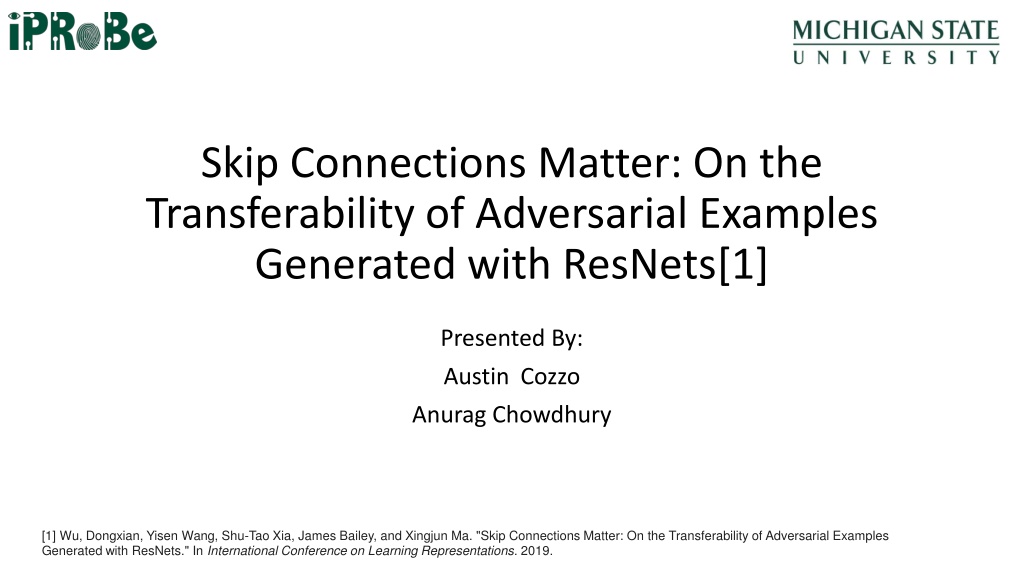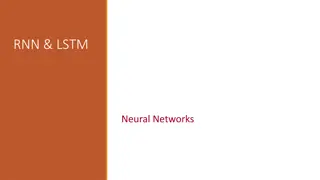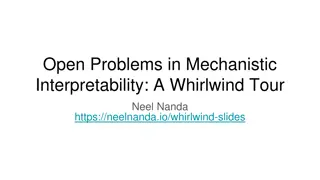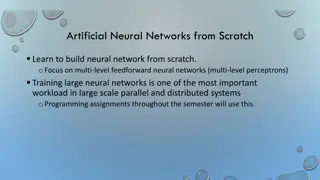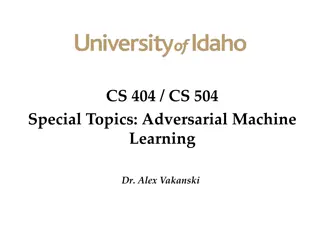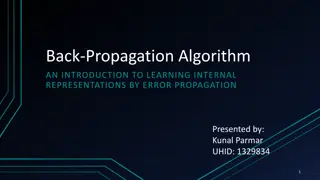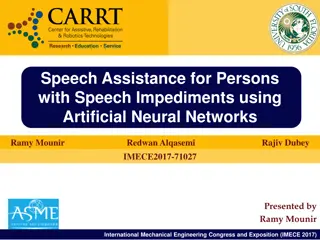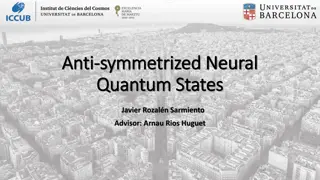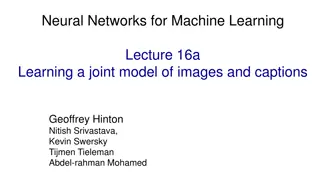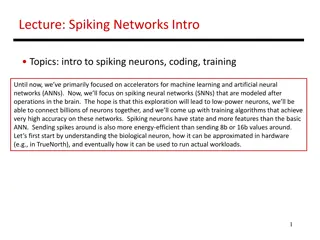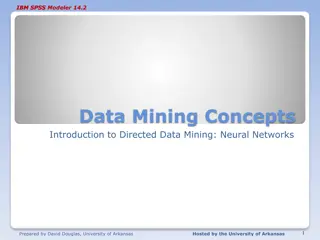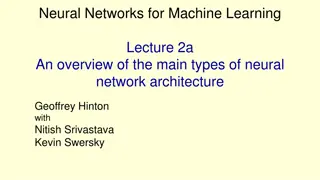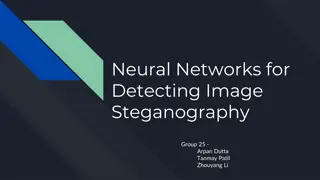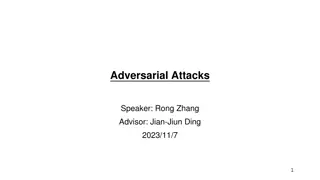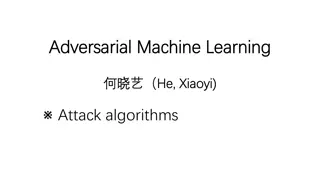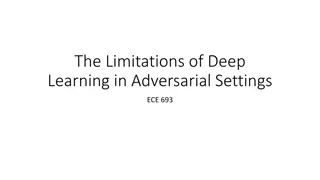Adversarial Examples in Neural Networks
Adversarial examples in neural networks refer to inputs intentionally modified to cause misclassification. This phenomenon occurs due to the sensitivity of deep neural networks to perturbations, making them vulnerable to attacks. By understanding the generation and impact of adversarial examples, researchers aim to enhance the robustness of neural networks.
Download Presentation

Please find below an Image/Link to download the presentation.
The content on the website is provided AS IS for your information and personal use only. It may not be sold, licensed, or shared on other websites without obtaining consent from the author.If you encounter any issues during the download, it is possible that the publisher has removed the file from their server.
You are allowed to download the files provided on this website for personal or commercial use, subject to the condition that they are used lawfully. All files are the property of their respective owners.
The content on the website is provided AS IS for your information and personal use only. It may not be sold, licensed, or shared on other websites without obtaining consent from the author.
E N D
Presentation Transcript
Skip Connections Matter: On the Transferability of Adversarial Examples Generated with ResNets[1] Presented By: Austin Cozzo Anurag Chowdhury [1] Wu, Dongxian, Yisen Wang, Shu-Tao Xia, James Bailey, and Xingjun Ma. "Skip Connections Matter: On the Transferability of Adversarial Examples Generated with ResNets." In International Conference on Learning Representations. 2019.
What are Adversarial Examples? Given a high-dimensional input vector ?, and a classification mapping ?: ? 1,2,3, ? , an adversarial example is a particular ? such that for some perturbation vector ?: ? = ? + ?? ? ?(?) Typically, some norm ( ) of ? is constrained, such that ? ? , where ? is a hyperparameter
What Makes a Neural Network Vulnerable to Adversarial Examples? The critical component of generating adversarial examples is the perturbation vector ? Neural Networks, particularly Deep Neural Networks (DNNs), create high-dimensional embeddings which are largely intractable and can be highly sensitive to these kinds of perturbations Moreover, the gradient of the DNNs pose a large indicator as to a potential perturbation vector
How Can We Create Adversarial Examples for Deep Neural Networks? When the classification mapping is DNN, a gradient of the loss function with respect to the input vector x ? ? ,? , where ? is the ground truth class label, can provide a simple indication of a potential perturbation vector For example, consider the Fast Gradient Sign Method (FGSM) [1] which is very simple on the surface, but can obtain 90% error rates with this generation method ? = ? + ? sign x ? ? ,? [1] I. J. Goodfellow, J. Shlens and C. Szegedy, "Explaining and Harnessing Adversarial Examples," in International Conference on Learning Representations, 2015.
White- and Black-Box Approaches FGSM is considered a white-box approach, where complete knowledge of the DNN is available including the values of all learned parameters. White-box attacks have poor generalization and require access to the DNN, which in terms of a real-world attack scenario is relatively unlikely.
White- and Black-Box Approaches Conversely, a black-box approach knows nothing about the underlying model. There are two major subgroups of black-box approaches Host models: These methods rely on using a host DNN to train a generation model with the hopes that it generalizes well to other DNNs. Black-box optimizations: These methods query the target DNN repeatedly in an attempt to uncover the gradient of the target network
Grey-Box Approaches A grey-box approach uses some inferred knowledge about the target DNN to help to create the perturbation vector For this particular example, we assume that a DNN has skip connections in the architecture, but do not know anything else about the network.
Role of Skip Connections in Deep Learning Skip connections are bridges which skip over a layer in a DNN. Such a layer and connection is considered a residual module. [1] Networks with multiple parallel skip connections are considered dense networks [2] Skip connections allow for DNNs to contain more layers, making a deeper network, while not losing the information from earlier layers despite the increased depth Figure: An example of a residual module with (grey box), skip connection (green arcs), and typical neuron connection (red lines). Replicated from [3] [1] A. Veit, M. J. Wilber and S. Belongie, "Residual Networks Behave LIke Ensembes of Relatively Shallow Network," in Conference on Neural Information Processing Systems, 2016. [2] G. Huang, Z. Liu and K. Q. Weinberger, "Densely Connected Convolutional Networks," in Conference on Computer Vision and Pattern Recognition, 2016. [3] Wu, Dongxian, Yisen Wang, Shu-Tao Xia, James Bailey, and Xingjun Ma. "Skip Connections Matter: On the Transferability of Adversarial Examples Generated with ResNets." In International Conference on Learning Representations. 2019.
Skip Gradient Method Because skip connections present another gradient to examine, the authors of [1] consider the gradient of these residual modules. ? 1 ? ??? ????+1 ??? ??0 ?? ? = + 1 ?=0 Here ?0= ? is the input of the network, ? (0,1] is the decay parameter, ??is the layer s output, and ??= ?? 1+ ??(?? 1) is the skip connection from the previous layer [1] Wu, Dongxian, Yisen Wang, Shu-Tao Xia, James Bailey, and Xingjun Ma. "Skip Connections Matter: On the Transferability of Adversarial Examples Generated with ResNets." In International Conference on Learning Representations. 2019.
Skip Gradient Method Using this gradient, an adversarial example can be constructed iteratively with the formulation ? 1 ? ??? ????+1 ??? ??0 ?? ?+1= ? ???? ???? + ? sign + 1 ? ?=0
Transferability of the Skip Gradient Method The authors of [1] show that the skip gradient method retains state-of-the-art performance to a variety of networks with residual modules Table: Transerability experiments the success rates (% ????? over 5 random runs) of black-box attacks and the grey-box skip gradient method. Replicated from [1] Networks evaluated: VGG19, ResNet, DenseNet, InceptionNet [1] Wu, Dongxian, Yisen Wang, Shu-Tao Xia, James Bailey, and Xingjun Ma. "Skip Connections Matter: On the Transferability of Adversarial Examples Generated with ResNets." In International Conference on Learning Representations. 2019.
Summary Adversarial examples rely on the generation of a suitable perturbation vector For DNNs, the gradient gives the greatest insight for currently explored adversarial example generation methods By utilizing an assumption about the underlying network architecture, the skip gradient method is able to create a generation method on a host network and perform at state-of-the-art levels on a variety of networks with skip connections.
Next Steps (Proposed Experiments) Understanding the classes of perturbation vectors generated with grey-box methods such as the skip connection method Can potentially be learned by creating a large number of adversarial examples and clustering the resultant perturbation vectors Understanding the ability to transfer domains with generation models which utilize grey-box methods Does a model which can produce good adversarial examples on networks trained on ImageNet perform well for adversarial examples on other networks?
